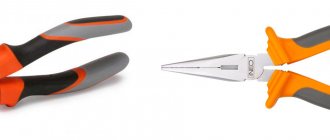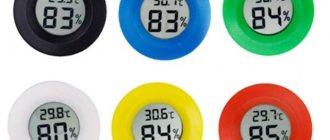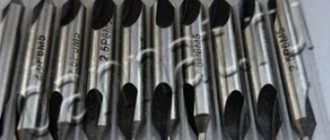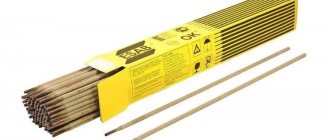Pliers and pliers are common and sought-after tools both at home and among professional craftsmen.
Meanwhile, many people confuse pliers with pliers, not seeing much difference in them. Below we explain the difference between pliers and pliers and which of these tools is the most popular and versatile.
Pliers by type
Pliers vary in their purposes:
- with short jaws for a strong and firm grip
- with extended jaws
- with narrow (or thin) lips
- with curved ones - when working in hard-to-reach places
- with internal plastic linings to avoid damaging parts
- specialized, for working with wire
The working (inner) surface of the jaws is smooth or with small shallow notches - for better grip of the object. “Jaws” is the part of the tool that grips parts.
What are they made of?
The purpose of the tool is determined by its design.
Pliers consist of the following elements:
- Two sponges that are made of metal. The hinge connects these elements to each other.
- A handle that is a continuation of the jaws. It is usually processed using special materials.
In many ways, the characteristics of the pliers depend on the materials used and the build quality of the tool.
You may be interested in Transformer for welding
Comfort of operation depends on the handles
The design of pliers is in many ways similar to pliers. However, in the first case there are several features:
- Connecting two parts using a hinge.
- The handle is characterized by a curved shape. The working surface is different in that it is flat.
- The handle is often made of plastic or rubber.
The scope of application of pliers is narrower than that of pliers.
Differences between pliers and pliers
Pliers are a metalworking tool that looks similar to pliers. Some versions - which can no longer be confused with pliers - use an adjustable hinge mechanism. The jaws of standard pliers are usually shorter than the jaws of pliers.
The name “pliers” is French, literally meaning “to clamp the rod.” And in order to clamp it tightly, on the inside of the edges, which are always corrugated - with notches, there is an oval or round depression, often two.
Tips from experienced users
To increase the service life of the tool, you should not use it for unusual work. Sometimes pliers are used as a stand when riveting metal parts with a hammer, or to hold live contacts. This leads to loosening of the hinge, and a strong spark when the contacts open can melt the jaws like welding. It is necessary to lubricate the pliers in a timely manner, wipe them from moisture with a rag, and clean them from aggressive chemical compounds. A careful and careful attitude will help keep the linings on the handles intact and increase the overall service life of the tool.
Which tool do you use most often?
PliersPliers
Their metal is good too
Higher quality and the metal from which the pliers are made. If carbon steel of a certain grade is used to produce pliers, then chromium is used in combination with molybdenum or vanadium to produce pliers.
They are used for
Although these instruments are characterized by almost the same external similarity, they actually have serious differences from each other. Moreover, the production of each tool is strictly regulated by its own standards, both in Russia and in the world (GOST and ISO, respectively).
Using pliers, you can perform the following actions:
- bend metal products;
- twist and, conversely, unscrew threaded connections;
- twist the wires;
- cut the wire;
- pull out nails;
- use as an aid when driving;
- use as an element holder.
You may be interested in Current measurement
Everything must be up to standard
Dimensions according to GOST
The sizes of pliers vary. There are “miniature” categories - for delicate and precise work, for example, bench modeling or beadwork - 10 centimeters.
The dimensions of tools for installation, plumbing, automotive and other work are specified in GOST 17 438-72. For pliers of the first group, he defines the length as 160, 180 and 200 mm.
The second group, intended for industrial work, fits into three types of lengths - 200, 250 and 300 mm.
Imported products, made in the EU, USA and China, come in sizes 10; 11.5 and 14 cm.
Material
Most often, when making pliers, the manufacturer uses steel grades 8ХФ and У7А. During manufacturing, the material is hardened by high-frequency current and also heat-treated, increasing its strength characteristics.
In order for the tool to successfully resist moisture and corrosion, oxidation and chrome plating technologies are used.Oxidized tools do not provide as good protection against corrosion, so they are intended mainly for work in indoor, dry rooms.
As for the material of the handles, it can be plastic, plastic with rubber linings, providing increased ergonomics, as well as special electrical insulating, allowing operation with voltages of up to a thousand volts.
The classifications and sizes of pliers produced for different applications may vary markedly.
What types of pliers are there?
Different types of pliers are used in production and everyday life:
- Universal
- Dielectric
- Combined
- Extended
- *Adjustable, sometimes called tubular
- For eyelets
If you compare photos of pliers of all the listed types, the differences are immediately obvious. Their main functions and purposes are listed below.
Pliers for all occasions
Universal pliers, or as they are also called - metalworking pliers, are often incorrectly called pliers. After the finely corrugated jaws, they always have a serrated notch. It is followed by side cutters - for cutting the wire, and next to the hinge there are cutters for cutting through stronger wire, nails and even chain-link mesh.
Pliers for eyelets
Eyelets, plastic or metal, are intended for strengthening holes in shoe, leather goods and other industries and workshops.
In view of this, “eyelet” pliers are a highly specialized and highly professional tool. They differ from other pliers in their specific appearance and are easily recognizable.
Pliers tools
Almost any type of locksmith work uses similar tools. All of them consist of a head, a handle and a movable axial joint . Since ancient times, blacksmiths have used large pliers in their work, with the help of which they held the workpiece on the anvil.
Over time, society, craft and tools changed. Simple pliers have evolved into a whole range of multifunctional and useful devices. Round nose pliers, wire cutters, pliers and pliers appeared.
Pliers for plumbers
Plumbing pliers are the largest among pliers. They are used exclusively for plumbing work. To grip large-diameter gas or water pipes, these tools use an adjustable hinge mechanism. Thanks to this, you can change - increase or decrease the diameter of the gear recess.
Common features
The tools are hand-held and belong to the category of pliers. They are similar in appearance. Therefore, many people are sure that devices perform the same functions.
The instruments are characterized by a simple design. The structure includes 2 metal sponges that perform key functions - holding, pinching, and biting. The tools also include handles that are connected using a hinge mechanism.
Expert opinion
Karnaukh Ekaterina Vladimirovna
Graduated from the National University of Shipbuilding, majoring in Enterprise Economics
The devices have a fairly simple operating principle. It is based on the same actions - closing and opening the jaws. When the handles are brought together, the jaws are compressed, and when they are spread apart, they are unclenched.
Such tools are considered the most popular. At the same time, they are actively used by both professional craftsmen and amateurs. The devices are used by mechanics, electricians, mechanics and representatives of other specialties. They are also often used in everyday life.











